Symbols: The Dragon
An exploration of the dragon, historically one to be conquered in the West and one to be revered in the East
The symbol of the dragon dates back many thousands years. It has flown through the mythology and art of almost every continent on the Earth with a perception distinctly unique from East to West. This resilience of the dragon symbol throughout human history endows it with a meaningful imprint into the modern psyche.
Throughout the history of Western society, the dragon often came to symbolise chaos, destruction, power, and the danger of passivity, and this is where the hero’s confrontation with the dragon emerged as a major theme. Though, it appears that this antagonistic perspective toward the dragon in the West is shifting. Meanwhile, Eastern traditions have long portrayed dragons as representations of life-affirming energies, harmony, and cosmic order, most notably in China. Unlike their Western counterparts, they are not adversaries to be conquered but powerful beings that guide and support humanity.
As we’ll come to see, the diversity in these representations in the East and West relate to their respective relationship with the conscious and subconscious aspects of the human mind. For the story of the dragon is in no small part a story of mankind itself.
Describing the Dragon
Protector · Sometimes chained · Immensely powerful · Beautiful soul · Fiery exterior · Water · Air · Heaven · Hell · Land · Fire · Emperor · Friend · Satan · Guards treasure · Life-affirming · Chaos · Destruction · Introverted · Extraverted · Loyal
The Dragon at Face Value
The dragon is entirely a human creation of the mind. Initially, most ancient dragons were depicted as serpentine creatures. For example, in early Egyptian mythology around 4000BCE, Apep, the embodiment of darkness and chaos, was created as a giant, legless serpent in perpetual war with the deity of the Sun, known as Ra. The serpent, both for biological and mythological reasons, came to represent mystery, danger, the duality of life and death, and inherent process of rebirth.
It is here we come across the Ouroboros, an ancient symbol of a serpent eating its own tail, and one of the earliest and most powerful representations of the cyclical nature of life and rebirth, dating back to ancient Egypt around 1600 BCE.
The serpent now begins to take on four legs. These dragons often had a hybrid form—part reptilian and part lion, tiger or eagle. Lions, with their majestic, powerful bodies, were combined in this way to evolve into dragons as creatures with a more formidable and grounded presence, acquiring legs for strength, speed, and mobility, and a connection to the Earth.
By the time of the Han Dynasty in China around 200 BCE, the common dragon starts to be more or less fully-formed with the following traits:
Serpent: The serpent body endows the dragon the fluidity to move effortlessly between realms (heaven, earth, and water).
Eagle: The claws of the eagle merge its keen vision and hunting authority into the dragon.
Lion or tiger: The legs of a lion or tiger symbolising their power and bravery.
Deer: The antlers seen on the head of the dragon often represent an air of regality, grace and wisdom, from an animal of innocence and purity.
Fish: The scales of the fish seen on the body of the dragon weave into the symbol of the dragon as a water deity and the abundance it can bring.
In China, this hybrid creature came to be a symbol of the Emperor himself, reflecting a belief that the Emperor was the “Son of Heaven.” The dragon emerged as a link between Heaven and Earth. While rooted in the ancient symbolism of the serpent, this hybrid dragon combining many species across land, sea and air, becomes a holistic creature with a sense of uniting opposites, fostering a harmony of yin yang and the capacity to transcend natural boundaries.
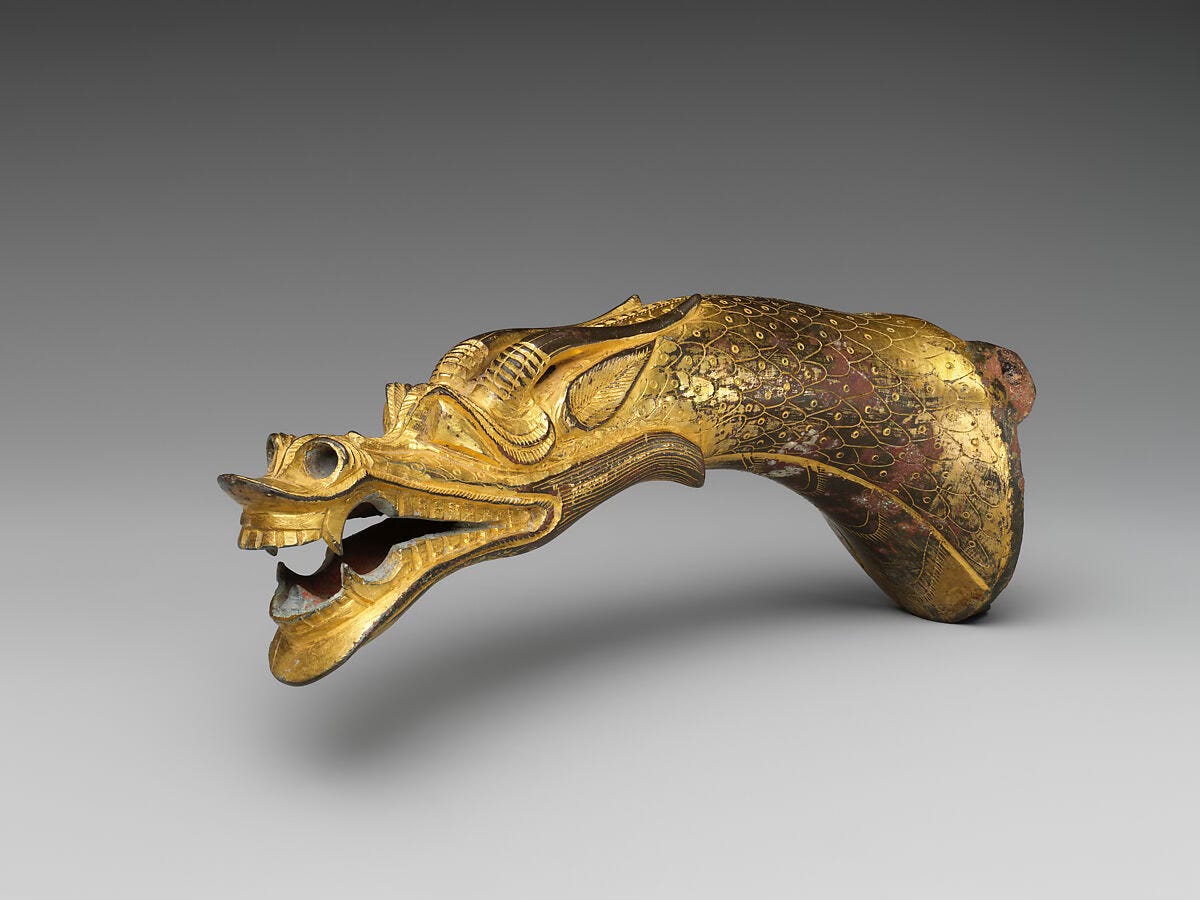
Meanwhile, on the other side of the Eurasian continent, Greco-Roman culture seems to be the birthplace of the winged dragon. While the Chinese dragon, also known as 龙, lóng, was often considered capable of flight without the need of wings, by the early medieval period in Europe wings were being included in many depictions of the dragon symbol. This endowed it with an otherworldly character that could master all of land, sea and air. In Greek, the original term given to the symbol was δράκων (drákōn), meaning "to see clearly" or "gaze sharply."
Eventually, in the Western tradition, the dragon came to breathe fire. The classic story of Saint George in the Middle Ages tells of a courageous Christian knight (Saint George) who confronted a monstrous, fire-breathing dragon to save a princess and liberate a kingdom. This picture would go on to be portrayed extensively in art and national emblems over the next millennia, west of Asia.
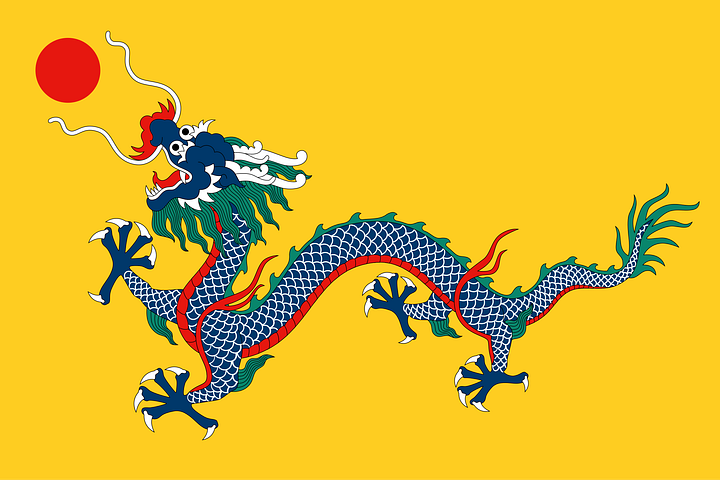
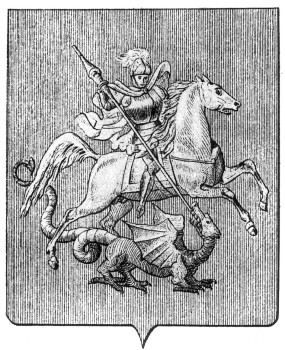
Understanding the Dragon
Importantly, do we have to understand the dragon? The perspective of this piece you are reading here, resoundingly contends, “No.”
If the dragon symbol sparks your curiosity and comes into your life, its meaning emerges from a world deep inside of you, and this is a world which only you can decipher and listen to. By inviting this symbol into your world and flowing with it as it comes, rather than trying to understand it, you open up to learning more about yourself and evolving as an individual.
The purpose of every section here is to serve as a guide in helping you explore and discover your unique relationship with the dragon symbol.
龙 Lóng
In China, we find probably the longest standing and most devout following of the dragon symbol. Known as 龙 lóng, as we saw earlier, it is often depicted as a giant and hybrid creature which dwells in either water sources or clouds. For many people in this region of the world, it has come to be associated with the life-affirming force known as qi. Chinese dragons are heralded as bringers of good fortune, health and abundance, yet if they are treated in the wrong way, can also erupt immense destruction by virtue of their command of the skies and seas.
The Chinese Zodiac
In the Chinese Zodiac, the dragon is one of the twelve animal signs and holds a place of honour and prestige. These animals are thought to influence the personality traits, fortunes, and compatibility of individuals born in that year. The system is deeply rooted in Chinese mythology, philosophy, and astronomy.
The dragon is considered the most auspicious and powerful of all the zodiac signs, and while it is the fifth animal in the twelve-year zodiac cycle, legend has it that during the race held by the Jade Emperor to determine the zodiac order, the dragon arrived fifth because despite its immense power, the dragon paused to help others, showcasing its benevolence.
People born in the following years are considered to be born in the Year of the Dragon: 1928, 1940, 1952, 1964, 1976, 1988, 2000, 2012, 2024 (The years repeat every 12 years in the Chinese lunar calendar.)
The Number 9
Numerology retains its importance in China to this day, and the number 9 is the highest of all the single digit numbers. Its relevance stems from the pronunciation, which is a homophone for the word 久 (jiǔ), meaning "long-lasting" or "eternal." Traditional thought divides the heavens into nine layers, with the dragon acting as a bridge between the earthly and celestial realms. This reinforces the dragon's role as a mediator of cosmic balance and harmony.
Further, in the I Ching (Book of Changes), 9 represents the ultimate potential for transformation and power in the yang trigram (☰ Qian), associated with heaven and the dragon. A famous phrase from the I Ching says:
“The dragon appears in the sky; it is time to ascend.”
The dragon and the number 9 symbolise upward movement, transformation, and the realisation of great potential.

The Dragon and Water Symbolism
Dragons possess a softer and more yielding aspect alongside their formidable nature. While they are at ease in all elements, it is water with which they are most commonly associated. The Tao, the way of the universe according to East Asian traditions, has a water-like nature: it is soft and yielding and yet it has the power to wear rock and shape the landscape. Chinese dragons are believed to be the rulers of rain, rivers, lakes, and seas. They control the vital water resources needed for agriculture and life. In this way, the dragon's association with water highlights its role as a mediator between the heavens and the earth, embodying the flow of life-giving energy in Chinese culture. And water itself has a dual nature: it can be either nurturing or destructive.
Water is also deeply intertwined with the notion of the subconscious part of the human mind, or that which lies below the conscious thought and feeling we experience. Just as the sea contains hidden treasures and dangers, the subconscious mind harbours hidden memories, emotions, and desires.
Across many cultures, water also symbolises cleansing and renewal. In psychological terms, this relates to the process of emotional healing, shedding past traumas stored within our subconscious, and transforming into a more integrated self. In this way, the dragon as a balance of opposites, is the medium through which this transformation can occur.
In Ancient Egypt, the Book of the Dead was rich with symbolism and emphasised the journey of the soul (or ka) through the afterlife to achieve eternal life. It describes the journey of the soul through the Duat, a complex, layered underworld filled with rivers, gates, and challenges. This journey is not merely physical but also spiritual, as the deceased must prove their moral worthiness, navigate obstacles, and invoke divine assistance. Many gates in the Duat are guarded by serpent-like creatures that test the deceased. These beings ensure that only the righteous can pass, requiring the traveler to recite specific spells or demonstrate purity, and symbolise the spiritual trials that test the deceased’s ability to uphold maat (cosmic balance and truth). Overcoming them affirms the deceased’s readiness to join the gods.
The Role of Christianity
Christianity significantly influenced the symbolism of dragons, reshaping their meaning in Western culture. We’ve come to see so far that on the eastern end of the cultural spectrum, the dragon is held in highest reverence. As we start to move west, into Mesopotamia and Ancient Egypt, the dragon continues to be associated with power, protection, creation and an ability to erupt chaos, yet there tended to be a greater fear and awe inspired by this symbol compared to Chinese lore, and it would often be paired with another neutralising deity to reflect this struggle between chaos and order in the balance of life. It is Christianity then which re-frames dragons as pure symbols of evil, Satan, and sin.
For instance, in the Book of Revelation, a great red dragon is explicitly linked to Satan, described as "the ancient serpent" who leads humanity astray:
"The great dragon was hurled down—that ancient serpent called the devil, or Satan, who leads the whole world astray. He was hurled to the earth, and his angels with him." (Revelation 12:9, NIV)
Christianity brought the responsibility of chaos and disorder onto the individual himself. One must atone for their sins. And the role of the light was God himself, with Christ as the redeemer. As it is written in the New Testament, where in the first epistle, John says, “God is light, and in him there is no darkness at all.” (John 1:5, NIV)
And so it was from the scriptures that became the Holy Bible, and the Church of Christ which was entrusted to interpret it for the people, the dragon now had to be conquered and slain by the individual, for the only way was the way of the light, of God.
The Hero’s Tale
“The universal hero myth always refers to a powerful man or god-man who vanquishes evil in the form of dragons and liberates his people from destruction and death.” — Carl Jung, Man and His Symbols; p68.
Over the course of the first millennia after Christ, the religion of Christianity devises for its people a new story around the dragon. It comes in the form of the creation myth, in which a serpent-like antagonist of the Creator appears and lures man to disobedience by the promise of increased conscious knowledge. And as Christianity would spread across the whole of the Roman Empire and beyond, so would grow the power of the hero’s tale.
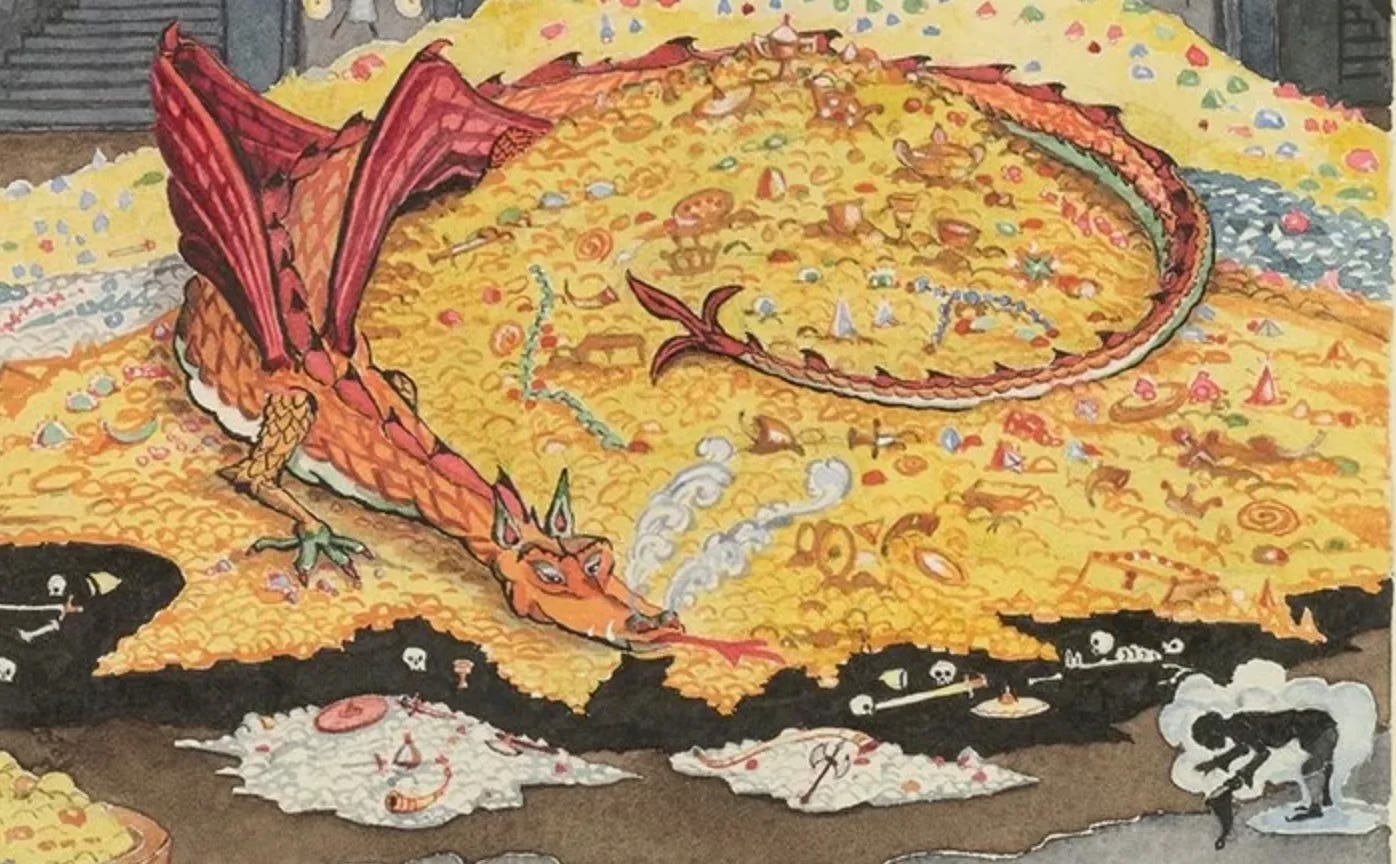
We’ve written earlier in this piece about the classic tale of Saint George which emerged in the 11th century BCE, and whose representation of the brave Christian knight slaying the dragon and rescuing the princess would be found in the emblems of countries far and wide for centuries to come.
More recently, J.R.R. Tolkien’s The Hobbit centers around an all-powerful dragon named Smaug and a tiny hobbit character by the name of Bilbo Baggins. Smaug represents evil, inner demons, and menacing greed, hoarding vast treasures in isolation. Meanwhile, Bilbo Baggins’ journey to confront the dragon mirrors personal growth and the rediscovery of courage. When Bilbo sneaks into Smaug's lair using the invisibility granted by the One Ring, he witnesses the vast treasure and the sleeping dragon. Bilbo cleverly engages Smaug in conversation, flattery, and riddles, learning about the dragon's vulnerabilities. Smaug, however, boasts of his nearly impenetrable armour of scales, with only a small weak spot in his chest where a scale is missing. Eventually, Bilbo, in cooperation with other creatures of the Middle Earth, defeats the dragon. Bard the Bowman, a skilled archer and descendant of the lords of Dale, manages to slay him by shooting a black arrow into the weak spot on Smaug's chest, as described by Bilbo.
21st century stories have started to look at the dragon in a new light. For example, in Harry Potter they are again introduced as giant winged, fire-breathing beasts. Widely regarded as terrifying yet awe-inspiring, they feature in the traditional hero’s journey, particularly in the tri-wizard tournament as creatures to be overcome, and amidst the underground depths of Gringotts Bank protecting the treasures of the wealthiest witches and wizards. Yet, we are also shown how an outcast in his own right, the giant Hagrid, develops a loving, nurturing relationship with the dragons. And how Hermione’s courage in the depths of Gringotts rescues both her and her friends, and the chained dragon itself. We see another side to the dragon, once again. In George R.R. Martin’s Game of Thrones, dragons also feature prominently. And here again, the dragon is represented to subvert their traditional role, being neither purely antagonistic nor entirely heroic.
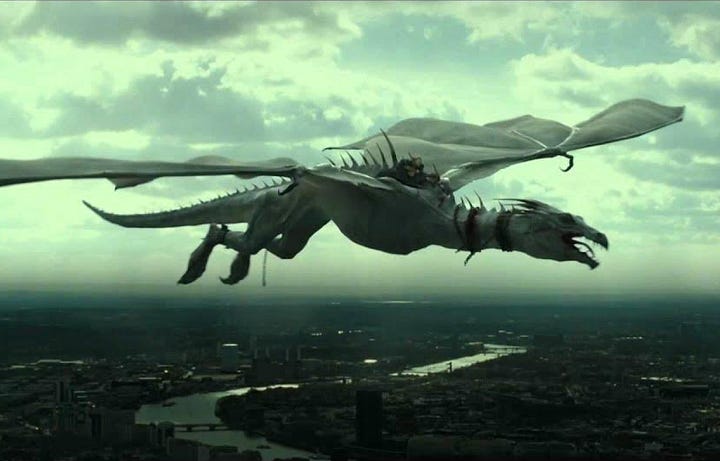
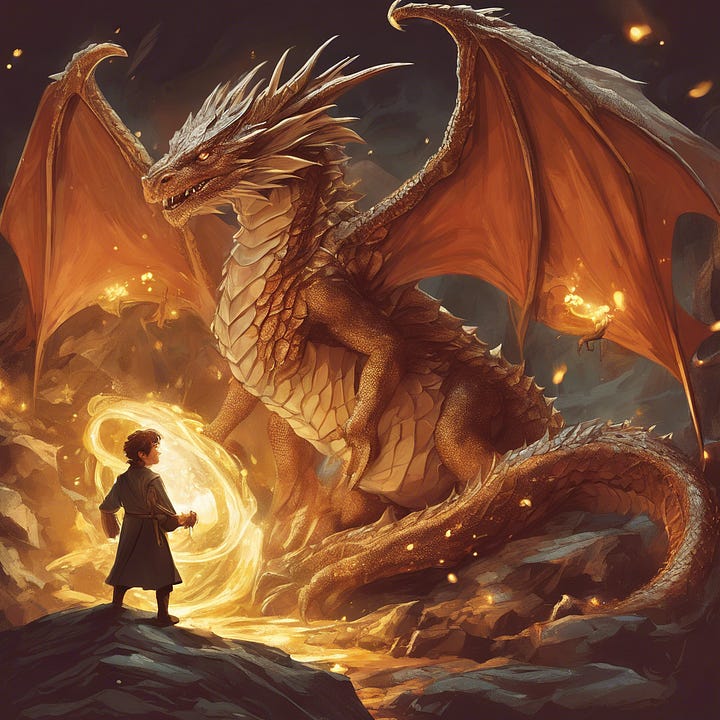
A Modern Shift
In the 2010 film “How to Train Your Dragon,” Hiccup is a Norse teenager from the island of Berk, where fighting dragons is a way of life. His progressive views and weird sense of humor make him a misfit, despite the fact that his father is chief of the clan. Tossed into dragon-fighting school, he endeavours to prove himself as a true Viking, but when he befriends an injured dragon he names Toothless, he has the chance to plot a new course for his people's future. Berk begins a new era of humans and dragons living in peace.
This a new narrative around the symbol of the dragon. And this series has spawned into a massive franchise incorporating additional films, TV series, comic books and more. It is not alone. In the enormously popular Pokémon game, the dragon-like Pokémon, Dragonite, is known for its kindness and protective instincts, often helping humans and other Pokémon. In the alternate-history fantasy series, Temeraire by Naomi Novik, the main character Temeraire is a highly intelligent and noble dragon who forms a deep bond with his human companion, Captain Laurence. Their partnership reflects mutual respect and affection.
We see a recurring theme of the modern dragon symbol involving the creature as a loyal companion, as one initially misunderstood, then subsequently revered, and as a powerful guardian.
Share more about your relationship with the dragon in the comments below.
The Serpent as a Bringer of Health
Asclepius is a figure from Ancient Greek mythology and religion, who was revered as the god of medicine and healing. His most famous symbol is the Rod of Asclepius, a staff entwined with a single serpent. It is widely recognised even to this day as a symbol of medicine and healthcare. It is said that in return for some kindness rendered by Asclepius, a serpent licked Asclepius's ears clean and taught him secret knowledge (to the Greeks these creatures were sacred beings of wisdom, healing, and resurrection)
Meanwhile, in India, the serpent is at the basis of a whole philosophical system of Tantrism. It involves Kundalini and the Kundalini serpent. While many individuals report to experiencing a temporal condition known as Kundalini awakening, this is something sustained with intention only by a few practitioners, for generally it is neither known that we have a serpent in the abdomen, nor is the ability appropriately developed to move this energy through the body. The Kundalini serpent is normally coiled quiescently at the base of the spine. When this energy is aroused in the practice of Kundalini Yoga, it uncoils and rises up the spine through six successive chakras, or centers of consciousness. The serpent power in Tantric Yoga or Kundalini Yoga is an attempt to reach the condition where Shiva (symbolising consciousness, the masculine) is in eternal union with Shakti (representing the feminine, activating energy). Shiva is then encircled by Shakti in the form of a serpent. It is a merging of consciousness and energy.
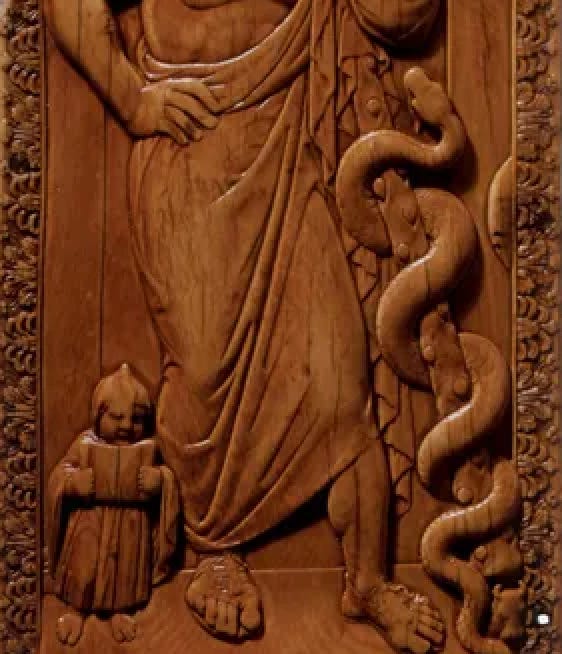

The Ouroboros
We have already touched on the symbol of the Ouroboros at the start of this piece. Now, in the final chapters, as we attempt a deeper dive into the psychology of the dragon symbol, it seems relevant to look into it once again.
Firstly, since psychology is an inherently personal and subjective matter, we pose a personal question:
What does the representation of a dragon wrapped around in a circle and eating its own tail mean for you?
One way to look at this symbol is through the lens of alchemy. Alchemy is a subject that has an equally diverse and long-standing history as the symbol of the dragon, and an array of purposes over the course of time. From turning base metals into noble metals like gold, to creating an elixir for life in the philosopher’s stone, to arriving at the wholeness of the individual and mankind itself. From a metaphorical perspective, these are all one and the same. The alchemical process of breaking down and reforming material into something new, is much like the way psychological growth requires decomposing old aspects of our personality to allow new attitudes to emerge. The dragon circles around itself devouring its tail, entering a cycle of transformation and renewal through a unity of opposites, and then the rebirth. From the perspective of the mind, we could say that which is unconscious becomes conscious and subsequently integrates into the whole of individual as they experience themselves in the present moment.

The Ouroboros thus initially surrounds the unconscious, protecting us from being overwhelmed by irrational impulses. It demands a level of conscious maturity before we can pass through deeper psychological layers and integrate them. It acts as a necessary dynamic barrier mediating between conscious and unconscious. This is possible for the dragon, because the symbol itself is a duality of opposites. The Ouroboros is then the mandala representing eternity.
The Four Elements
We’ve seen how in Eastern traditions, the dragon would typically be portrayed amidst the air in the clouds or down below in the waters of the seas. Water and air. And we’ve also seen how in the Western tradition, the dragon would often be portrayed on earth, guarding treasure, conquered by man while breathing fire all around. Fire and earth. The symbol of the dragon integrates them all.
Physically, the dragon is menacing, powerful, aggresive and masculine. Metaphysically, it is a source of creation, renewal, wisdom, and the feminine.
It is capable of both chaos and order. Protector and destroyer. Loyal and unpredictable.
The Extravert and the Introvert Meet the Dragon
Expanding on this duality of the dragon, we now move into the personality types. The outward focused extravert, and the introvert with their inward tilt.
If the extravert meets an object in the outside world they are enamoured with, they will inherently seek to blend in with it. The extravert merges with the object of their affection. However, if that object is chaotic and fiery and dark, the natural reaction is to project a need for control and clarity onto it.
In the case of the introverted type, the focus is on the subject themselves. And so begins the creation of a mythological world on the inside of the individual, and in doing so they attempt to create sense of comfort and stability for all the chaos the dragon represent in the material world.
The Psychology of the Dragon Symbol
By now, if you’ve come this far, you may be connecting certain dots for yourself from the variety of representations associated with the dragon across East to West. I present one interpretation of the psychology of the dragon symbol and a fork in the road for the future to come.
From the perspective of the mind as the point of focus now, the Eastern view historically looked upon the inner world of the subconscious as the all-mighty, and much like the dragon, they approached it with reverence and as a life-affirming energy. This character type listens to the inner world and lives through it in many ways. On the other hand, the Western view from the birth of Christianity onward tended to look upon the subconscious as something to be feared, and their approach was to seek to conquer this inner world.
The Western man willingly moves away from the depths of the subconscious, and upward toward rationality and determinism. The Eastern man is comfortable swimming within the subconscious and uses it as a filter for how to live their conscious life in harmony. Both ways of living have their own unique uses.
The proponents of the harmony of the inner world way of life, may indeed have found a sense of harmony in their lives, yet they continued to exist in the cycles of chaos and order incumbent from nature itself, including the nature within. What we may call a psychotic episode today, would be perfectly natural to this way of life. The thunder last night was responsible. Their understanding of and ability to control the physical world, and themselves, was simply undeveloped to live any other way. They co-existed with the dragon, because they had to. And the dragon came to reflect the relationship with their inner world.
Meanwhile, the proponents of conquering the inner world, gradually morphed Christianity into science and then into a techno-utopia full with a plethora of information and knowledge about the physical world. By becoming rulers, in many ways gods, of the Planet Earth and Mother Nature, they have very clearly slain the dragon, and domesticated it like any other fluffy pet. Yet, their understanding of their own nature within, still comes up as an empty box. Science and technology have not been able to discern any meaningful understanding of the qualitative nature of nature itself, including the human mind.
One example of this interpretation of the East and West, is the evolution of China and the Western Powers (first the UK and then the USA) when this willpower toward rationality started to truly come into its own. China was an innovative and vast empire for millennia, with incredible knowledge and traditions, yet while the West transitioned into the Industrial Revolution, the Eastern way of life apparently did not see a reason to adapt. Soon enough, the West had conquered China starting with the Opium Wars. China has since been forced to adapt its ways to the Western approach. A similar story played out in Japan. Following the invasion of the imperial powers of the Dutch and British, Japan began to “modernise” and within a century became one of the wealthiest regions in the world.
However, this industrialisation is an extremism. Slaying the dragon and converting it into just another toy to control, is analogous to numbing the entirety of one’s subconscious. Indeed, this rapid global industrialisation has led to an exponential destruction of the natural world, alongside an equally exponential rise in the population of mankind which the Earth may not be able to sustain. If the analogy of the physical natural world is to the inner subconscious world of the human mind, then humanity can done an exceptional job in slaying its dragons. Without this natural world, what happens next? Existence necessitates the duality of that which is seen and that which is unseen. Without it, we come back to the Ouroboros, where One is All, All is One, the cessation of existence itself.
This may well be path that humanity appears to be on. For only the individual who confronts and triumphs over the dragon without being consumed by it can claim the "treasure hard to attain." Yet, humanity has indeed been consumed by it. For fighting against this uncertainty toward determinism has been its resounding mission for centuries. The “treasure” on this particular path might just be the evil that has been suppressed by Christianity with its one-sided approach: “God is light, and in him there is no darkness at all.” Is it undoubtedly merely a speculation, yet the new artificial world and incumbent artificial general intelligence, which much like the subconscious, few can understand and control, might be the future polar opposite to the consciousness of the human. As humanity enters a new cycle, we may once again see the control of the human by the subconscious, as the tribal man lived millennia ago. In this new cycle, it may well be China that leads the way, for while the conscious rationality of life led by the Western power has dominated mankind for many centuries, the subconscious is the realm of the Chinese.
However, this is not the only path available.
When the symbol of dragon becomes integrated into both the introvert and extravert, into the rational feeler and the sensitive intuitive, into the East and West, they are reconciled into one, the beginning and end of all transformation, reflecting the human soul’s quest for balance and unity.
Her Triumph, by W. B. Yeats
I did the dragon's will until you came
Because I had fancied love a casual
Improvisation, or a settled game
That followed if I let the kerchief fall:
Those deeds were best that gave the minute wings
And heavenly music if they gave it wit;
And then you stood among the dragon-rings.
I mocked, being crazy, but you mastered it
And broke the chain and set my ankles free,
Saint George or else a pagan Perseus;
And now we stare astonished at the sea,
And a miraculous strange bird shrieks at us.
Finally, What Does the Internet Have to Say?
I asked ChatGPT: “What does the internet via forums such as Reddit, Twitter, Quora say about dragons, and what they represent personally to each individual?”
Response Summary-
Common Threads: Across these various interpretations, dragons often represent a balance between power and wisdom, freedom and responsibility, mystery and clarity. They evoke feelings of awe, wonder, and personal connection, offering a symbolic framework for people navigating their own struggles, creative endeavors, or spiritual quests.






Interesting story, thank you for sharing ❤️